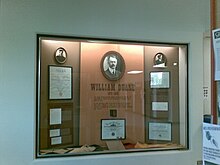William Duane

William Duane (born February 17, 1872 in Philadelphia , Pennsylvania , † March 7, 1935 in Devon , Pennsylvania) was an American physicist .
Duane was descended from Benjamin Franklin in the 5th generation . He studied from 1888 at the University of Pennsylvania (with the bachelor's degree as the best of his class), from 1892 at Harvard University ( master’s degree from 1895 with John Trowbridge ) and from 1895 as a Tyndall Fellow at the University of Göttingen and the Humboldt University of Berlin , where he studied with Max Planck and received his doctorate in 1897 (with Walther Nernst ). From 1898 he was a professor of physics at the University of Colorado . From 1908 to 1913 he was in the laboratory of Pierre Curie and Marie Curie in Paris and during this time he dealt with radioactivity, which resulted in several publications (but none directly with Marie Curie). From 1913 he was Assistant Professor of Physics at Harvard and from 1917 Professor of Biophysics at Harvard. During this time he dealt mainly with the medical use of X-rays, especially against cancer, and worked partly in the Huntington Hospital. In 1934 he retired. Long before that, however, he was severely handicapped by his diabetes and, for example, lost parts of his eyesight in 1927.
The Duane-Hunt law in the physics of X-rays is named after him. He was also known for a method of determining the radiation dose by means of X-rays via the ionization of the air, which he also helped to gain international recognition at an international congress in Stockholm in 1928. He also developed methods to extract radon , which was used for cancer treatment.
In 1924 he was involved in a controversy with Arthur Holly Compton , because he made observations deviating from Compton's explanation during his own independent measurements of the Compton effect, including a material dependency, which he attributed to a secondary interaction of photoelectrons released by the X-rays with matter. In the end, however, Compton prevailed.
1923–1924 he was president of the American Association for Cancer Research and 1922/23 head of the physics department of the National Research Council. In 1923 he received the Comstock Prize of the National Academy of Sciences , of which he was a member. He was also a member of the American Academy of Arts and Sciences (1914), the American Physical Society , the American Philosophical Society (1920) and the American Association for the Advancement of Science .
In 1922 he received the John Scott Medal of Philadelphia and in 1923 the Leonard Prize of the American Radiological Society. He received honorary degrees from the University of Pennsylvania and the University of Colorado. A physics building at the University of Colorado is named after him.
He had been married since 1899 and had four children.
Web links
Individual evidence
- ↑ He published his first publication in 1895 on the speed of propagation of electrical waves in wires
| personal data | |
|---|---|
| SURNAME | Duane, William |
| BRIEF DESCRIPTION | American physicist |
| DATE OF BIRTH | February 17, 1872 |
| PLACE OF BIRTH | Philadelphia , Pennsylvania |
| DATE OF DEATH | March 7, 1935 |
| Place of death | Devon , Pennsylvania |